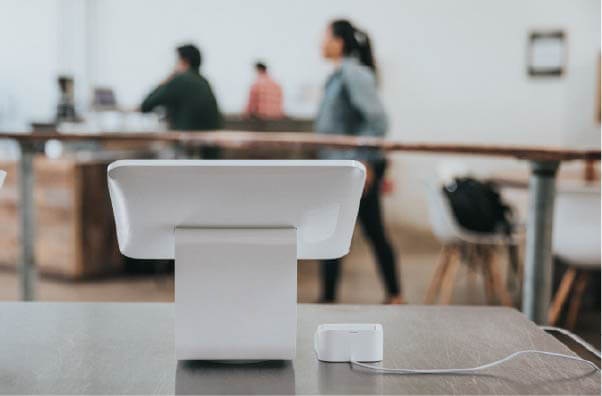Self-service kiosk implementation is one of the most important steps a hotel can take towards improving the customer experience, ensuring seamless operations while at the same time reducing the amount of manual tasks during the check-in and check-out processes. When implemented correctly, a kiosk can be a step in the right direction towards maximum profitability.
By taking the manual tasks out of the hands of the front desk, your staff can instead focus on providing the best service possible, and creating a lasting first impression. Because kiosks are such an important factor in providing excellent service, we’ve laid out six easy steps in order to ensure successful self-service kiosk implementation. Keep reading to discover our tips.
Learn more about what is self service kiosk.
Table of contents
Successful self-service kiosk implementation in six easy steps
Successful self-service terminal implementation starts with having a plan, so follow these six easy steps to help guide you towards an effective execution.
Choose a supplier
Choosing the right check-in kiosk is an important decision. Make sure you choose a supplier like Mews who offers you the ability to fully integrate with your PMS ecosystem. The more tools that are integrated, the more you can streamline your operations and have all your processes flow together more smoothly.
Beyond integration, it is important that you have the ability to personalize your terminal with your brand’s colors, logo, and default language based on your hotel’s location. Set-up should be easy and straightforward, and guests should be able to check themselves in and out of your facilities contactlessly.
Devise a plan
This may seem like an obvious step, but in the busy day-to-day operations of a hotel, it’s easy to get off track. Important things to consider in your plan of attack are:
- Who will be your point person in case an issue should arise? Machines will occasionally have technical issues, and for this reason it’s important to have someone in charge should there be any problems or should the less tech-savvy guests need help.
- Where is the most logical place to set it up? Of course, it should be placed in reception, but ideally it will not get in the way of the regular flow of operations.
- What kind of signage will you create in order to guide people towards the kiosk?
- What kind of communications will you send pre-arrival to ensure that guests are aware of the option to use the terminal and its different functionalities?
Keeping these four things in mind before you set up the kiosk will ensure that it is more successful and that it becomes an integral and useful tool in your operational flow.
You may also like:
Design a communications strategy
Both the messaging within the terminal as well as pre-arrival messaging should be such that you introduce your guests to the technology. Messaging should be friendly, helpful, and straightforward. Of course, a machine can never fully replace a human being, but nonetheless, the interaction your guests have with the machine should be in line with the experience you would like them to have with your staff.
Consider sending information about your new service in your pre-arrival messaging. If you educate them about the advantages (for example: no wait, check in 24/7, fast check-out for those in a rush), guests will be more prepared to embrace the technology. Everything new requires education, but once guests get used to it, there’ll be no turning back.
Be sure to have support options available
Having support available is important to a successful kiosk implementation. Support should be both in the way of the supplier and by way of your team. This means having a dedicated person to take care of any troubleshooting or to do some hand-holding for the less tech-savvy guests. Some suppliers will offer different support packages depending on your hotel’s needs, make sure to choose the one that covers you for all occurrences.
Even if you have a designated point person, all of your staff should be trained to be able to use the technology correctly because staff that are prepared provides better service overall. Also, you want to make sure that your supplier is available should any more difficult technical issues arise.
Choose the ideal location
We’ve mentioned the fact that it’s important to have an idea of where to put the kiosk and ensure that it doesn’t interfere with regular operations, but it’s also important to consider having the right signage in place in order to lead guests towards using it. A good rule of thumb is to choose an area where there is a lot of foot traffic and with good illumination; both of these tips will help with the success of implementation.
It should of course be placed in an area that is the most natural for your operational flow. If you want to use it as a potential option for check-in and check-out during peak times, make sure that it is close to the reception, but not so close that it gets overlooked. Think about having signs at the reception that allow guests to make a decision about whether or not they want to wait in line at the front desk.
Discover some keys to lobby design to help you choose the right location.
Use the kiosk to increase revenue
Once you’ve designed an implementation plan, created a communications strategy and chosen the ideal location for the terminal, it’s important to consider using its potential for cross-selling and upselling. Upselling and cross-selling will help increase the average spend per booking.
Think about what options you will build into the user journey to increase the chances for upselling. Will it be offering an upgrade? The possibility to book additional services? Make reservations at the hotel? Or will you allow guests to reserve event tickets? All of these options create the opportunity for ancillary revenue and hence help boost your hotel’s profitability.
Learn more about cross-selling and upselling.
Conclusion
In this article, we’ve looked at the six key steps for proper kiosk implementation. It starts with designing a plan, choosing the right supplier, creating a communication plan, having support available, choosing the right location, and ends with using the kiosk for upselling and cross-selling potential.
By following the steps laid out for a successful implementation, you can be sure to maximize your hotel’s profitability, reduce overhead costs, improve your operations and increase guest satisfaction. When implemented properly, this technology provides convenience, cost-effectiveness and can improve the overall workflow of your hotel.
Want to understand how Mews Kiosk can boost hotel revenue and service?
Download our guide "Mews Kiosk: 6 creative uses for properties of all types"


2026 Hospitality Industry Outlook
Download now
Table of contents
Hospitality hot takes straight to your inbox



.webp)
